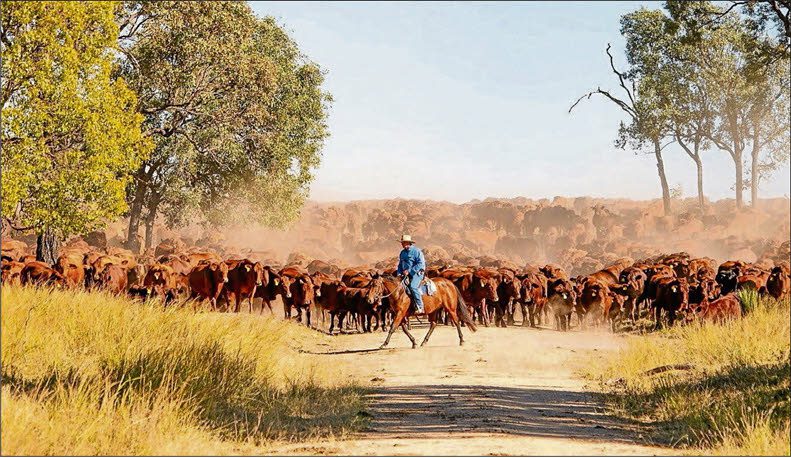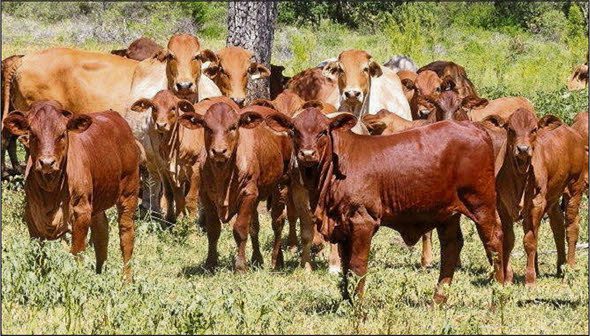Northern Game Changer

Imagine branding 450 more calves, per 1000 cows. Ian Stark said this potential is indicated by research which has included Seifert Belmont Reds.
Seifert Belmont Reds are breeding success
Ian Stark and Jeanne Seifert of Seifert Belmont Reds, take great pride in the purebred females they produce.
This consideration was highlighted at the 2024 Callide Dawson Beef Carcase Competition where they entered heifers for the first time and came away with ribbons for reserve champion grass fed heifer carcase, second place for their pen of three grain fed trade heifers, as well as champion grain fed steer carcase and reserve champion grain fed steer carcase. This came after the stud won the champion grain fed steer trophy, and scored seven other wins and placings, in the 2023 competition as first-time competitors.
Mr Stark said as a tropically adapted Bos Taurus the Belmont Red is unique, in that its Africander breed base differentiates it from the Bos Indicus breeds. "Seifert Belmont Red bulls over Bos Indicus cows add outstanding fertility and temperament, plus early finishing, short-sheathed, polled, high meat quality, flat backs. Over British or Euro breeds they add tropically adapted traits such heat, tick, fly, drought resistance and a sleek coat," he said.
"By improving fertility, meat quality, and temperament without compromising survivability, our bulls are changing the face of largely Bos Indicus herds in the wet and dry tropics of North Queensland, the gulf, Northern Territory and the Kimberley region of Western Australia.
"The Belmont Red provides the only Breedplan recorded African genetics in Australia. This gives commercial cattle producers a perfect out-cross option to maximise hybrid vigour over Bos Indicus breeds or British/Euro breeds. "In their 3000-head female herd, Mrs Seifert said their best cows are the pregnant ones, and for Seifert Belmont Reds that equates to about 90 per cent of the herd annually.
"If you don't get a calf every year, every other trait is meaningless. This means every cow must wean a calf every year, from a nine week joining as a heifer to a 12-week joining as a wet cow, until she culls herself out at or before about 15-years-old. We have one joining, and one weaning," she said. In the Seifert Belmont Red herd, the 2024 pregnancy rate for rebreed for yearling mated, wet heifers, was 99.4pc PTIC, from a nine week joining.
"You just can't make this stuff up. These heifers were in the Calf Alive Research project - they were joined at 14 to 15-months-old, calved at two-years-old, and all bar one fell pregnant while raising a calf. That is an incredible achievement for any breed, anywhere.
"However, we already knew our females were super fertile from the Northern Beef Genomics Research project, where our heifers were ovarian scanned and had a corpus luteum as light as 216kg, and our herd ranked in the top five per cent for early puberty.

Seifert Belmont Red genetics are proving to add higher fertility to the predominantly Bos Indicus-based herds of the north.
"Earlier still, in the Cash-Cow Research project, when our herd was solely in marginal ticky, spear grass, lantana country, our wet re-breed on maiden heifers was 45.5pc better than all other herds. "We're grateful to benefit from enormous learning opportunities by being involved in research projects, which enables us to choose best practices in all aspects of our cattle breeding business."
Every animal in the herd is Breedplan recorded and DNA sire and poll/horn verified, with bulls also having genomic GBVs. "EBVs and GBVs provide us with highly predictable estimates of our animals' genetic potential." Mr Stark said genetics are the only heritable component in any herd, and their carefully balanced approach to breeding combines their best genotypes with their best phenotypes.
"If you want to make money you need to focus on genetics. So, every year every female is matched to the best sire to complement her. Each mating group is individually statistically designed to maximize profit and to manage relatedness.
"Our deep and pure Belmont Red pedigrees, going back to 1956, also ensure that our genetics deliver highly consistent and predictable first-cross calves for our clients."
For management, Mrs Seifert said they don't do a lot other than the usual vaccinations. "We hear a lot of people say they run their breeders under strictly commercial conditions, but most commercial breeders and studs dip and treat their cattle for ticks and fly or handle them especially to 'make them quiet'.
"Instead, we run our breeders under strictly natural conditions. We've never treated for ticks or fly and have applied survival of the fittest type principles - that is, if any individuals get so affected by heat, fly, ticks, or tough times, that they don't fall pregnant, they will cull themselves out as empties.
"Our breeders are run on our forest block between Eidsvold and Chinchilla and are joined naturally with our bulls at one to two per cent. They 'cook for themselves' with no interventions or treatments, other than urea lick during winter and phosphorous in summer."
Following a decade of progressive herd and property expansion, 2025 is the first time Seifert Belmont Reds will have volume surplus stud heifers available. Subsequently, 40 PTIC registered breedplan recorded heifers will be offered alongside 90 bulls at this year's annual Seifert Belmont Red Sale to be held on-property at Jandowae, and online via AuctionsPlus on Monday, August 11 from midday.